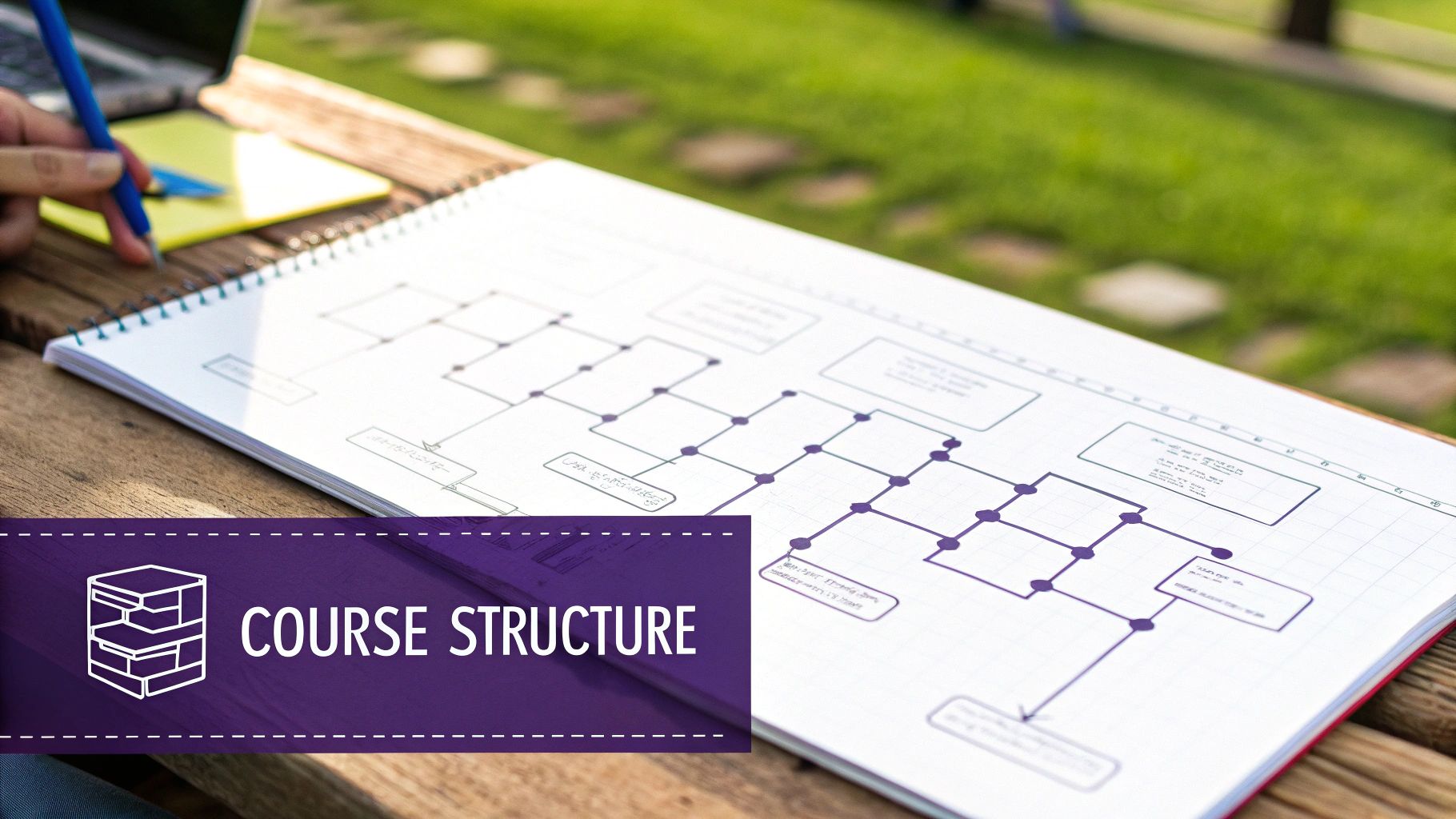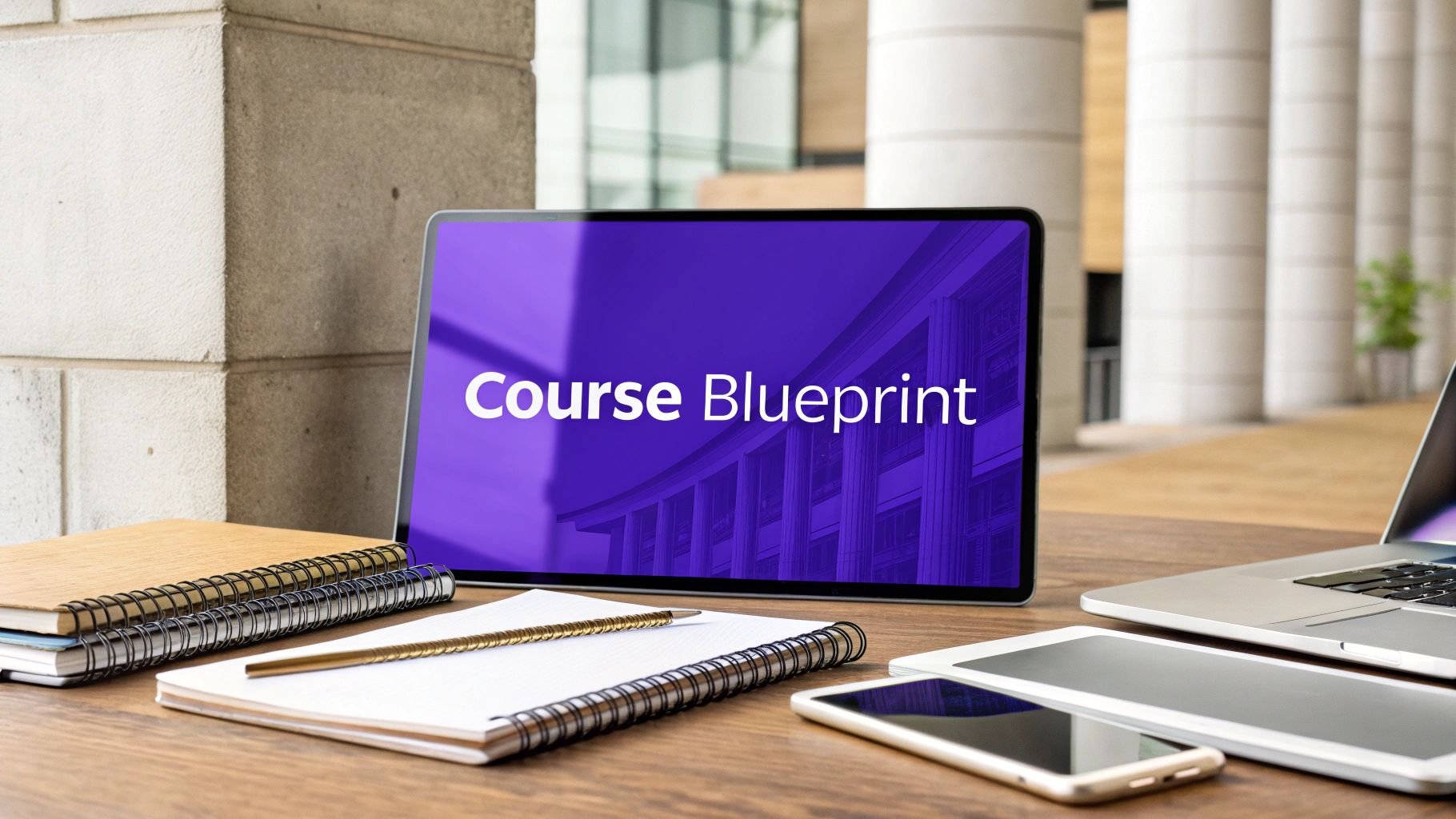Why Your Course Outline Makes or Breaks Learning

A well-structured course outline is essential for effective learning. It serves as a roadmap, guiding both instructors and students through the educational journey. This careful planning has a significant impact on teaching effectiveness and, ultimately, student success. A strong outline provides a framework that cultivates a positive learning environment and sets the stage for acquiring knowledge.
Psychological Safety and Clear Expectations
A detailed course outline offers students a sense of psychological safety. Knowing what to expect reduces anxiety, allowing them to concentrate on learning the material. This predictability fosters confidence and gives students a greater feeling of control over their learning.
A clear outline also sets clear expectations regarding the course content, assignments, and assessments. This transparency promotes fairness and helps students understand how their work contributes to their final grade.
Additionally, a well-defined course outline establishes clear learning pathways. It breaks down complex topics into smaller, more manageable segments, creating a logical flow of information. This structured approach improves both comprehension and retention. Think of it like constructing a building: a blueprint (the outline) is crucial. Without it, the building process becomes disorganized, and the final product is likely to be flawed.
Engagement and Knowledge Acquisition
This structured approach to learning is a stark contrast to early attempts at using media in education. For example, television was explored as an educational tool as early as the mid-20th century. Between 1955 and 1957, televised courses in subjects like chemistry and economics were offered, highlighting both the potential and the difficulties of this method. Explore this topic further This historical context emphasizes the ongoing importance of thoughtful planning in education, no matter the delivery medium.
A course outline also plays a vital role in boosting engagement. When students understand the overall structure and how each element contributes to the learning objectives, they become more invested in the process. This increased engagement translates to heightened motivation and more active participation in the course.
Finally, experienced educators understand that a course outline is a valuable tool. It isn't merely an administrative task, but a dynamic document that informs their teaching and facilitates student learning. These educators use the outline to create the cognitive scaffolding that students need to build on prior knowledge and develop new understanding. By aligning the outline with learning objectives and assessments, they ensure the course effectively guides students toward achieving the desired learning outcomes. This intentional design allows instructors to strategically pace the flow of information, minimizing cognitive overload and maximizing learning potential, contributing to a successful and enriching educational experience.
Essential Elements Every Course Outline Needs

A strong course outline is the foundation of a successful learning experience. It's more than just a list of topics; it's a roadmap guiding both the instructor and the student. A well-crafted outline transforms a collection of information into a dynamic learning journey.
Defining Clear Learning Objectives
The cornerstone of any effective course is clearly defined learning objectives. These objectives should adhere to the SMART principle: Specific, Measurable, Achievable, Relevant, and Time-bound.
For example, "Understand marketing" is too broad. A SMART objective would be "Develop a basic marketing plan for a small business within three weeks." This specificity gives students a tangible goal. It also helps instructors focus their content creation and assessment design.
Structuring Content Logically
With clear objectives set, the next step is structuring the course content logically. This involves content sequencing, arranging information in a way that builds naturally upon prior knowledge. Start with foundational concepts and progress to more complex ideas.
This structured approach ensures a smooth learning curve and promotes deeper understanding. It prevents students from feeling overwhelmed and facilitates a better grasp of the material.
Balancing Cognitive Load with Pacing
Pacing is crucial for an effective course outline. It involves strategically distributing content to manage students' cognitive load. Incorporate breaks, activities, and opportunities for reflection.
This balanced approach prevents burnout and improves information retention. Just like a marathon runner, students need periods of exertion and rest for optimal performance. Check out our guide on best practices for online courses for more information.
Designing Effective Assessments
Assessments should measure genuine understanding, not just rote memorization. Align assessments directly with your learning objectives to accurately gauge student progress.
This alignment ensures consistent evaluation and provides valuable feedback for both students and instructors. For more insights into how course outlines contribute to leadership development, explore the principles of effective Leadership Development Programs.
The Rise of Digital Learning
The increasing popularity of online learning underscores the importance of adaptable course outlines. Platforms like Coursera have seen a significant rise in enrollments. For instance, the 'Global Trends for Business and Society' course boasts over 18,714 students. Find more detailed statistics here.
This growth highlights the demand for flexible and accessible education. We need to think strategically about using digital tools to create dynamic and engaging online learning experiences. Consider exploring resources like How to master online courses in 2025.
To further illustrate the essential elements, the table below outlines the key components of a comprehensive course outline:
This table presents the critical elements that should be included in any comprehensive course outline, along with their purpose and impact on the learning experience.
| Component | Purpose | Impact on Learning |
|---|---|---|
| Learning Objectives | Define what students will achieve | Provides clear goals and direction for learning |
| Content Sequencing | Structure information logically | Facilitates understanding and prevents cognitive overload |
| Pacing | Manage cognitive load and distribute content effectively | Improves retention and prevents burnout |
| Assessments | Evaluate student understanding and progress | Measures achievement of learning objectives and provides feedback |
| Digital Tools | Enhance engagement and accessibility | Creates dynamic and interactive learning experiences |
Key takeaways from this table emphasize the importance of a well-structured outline with clear objectives, logically sequenced content, appropriate pacing, and effective assessments, all enhanced by the use of digital tools. These elements work together to create a robust and engaging learning environment.
Crafting Learning Objectives That Actually Work

Learning objectives form the foundation of any successful course outline. They act as a roadmap, highlighting the knowledge and skills students should gain. However, creating objectives that genuinely drive meaningful learning outcomes can be a challenge for many course creators. This section explores practical approaches to crafting learning objectives that go beyond generic statements and inspire real results.
Moving Beyond Vague Aspirations
Learning objectives are often too broad, lacking concrete direction. For example, a statement like "students will understand project management" is vague. What constitutes "understanding"? How can this understanding be measured? Such a lack of clarity can confuse both instructors and students.
Instead, aim for specificity and measurability. A more effective objective would be: "students will be able to develop a project timeline, allocate resources, and manage risks within a simulated project environment." This detail provides a clear target for students and enables instructors to design assessments that accurately gauge progress.
Aligning Objectives with Cognitive Taxonomies
Strong learning objectives consider different cognitive skill levels, from basic recall to higher-order thinking. Bloom's Taxonomy, a popular framework, categorizes these skills into six levels: Remembering, Understanding, Applying, Analyzing, Evaluating, and Creating. A well-structured course outline incorporates objectives that address multiple levels of this taxonomy.
A lower-level objective might ask students to "define key marketing terms," while a higher-level objective could challenge them to "analyze a marketing campaign and suggest improvements." By incorporating a range of cognitive levels, the course provides a more comprehensive and engaging learning experience. Check out these Top learning objectives examples for more teaching strategies.
Ensuring Alignment with Assessments
Learning objectives should always align with course assessments. This ensures students are evaluated on the material they are expected to learn. If an objective focuses on problem-solving, assessments should also require students to demonstrate this skill. This connection between objectives and assessments creates a clear path for student success.
This alignment is crucial even in advanced courses, like those exploring global trends, as exemplified by UCLA's MGMT 298D course. This course focuses on analyzing global trends and their business impact, developing students' analytical skills. Discover more insights about global trends in business.
Real-World Examples of Transformative Objectives
Well-crafted learning objectives can lead to significant learning outcomes across various disciplines. In history, an objective might ask students to "evaluate the impact of historical events on contemporary society." In science, students could be challenged to "design an experiment to test a scientific hypothesis." These real-world applications highlight the potential of learning objectives to boost student engagement and deep learning. These action-oriented objectives clearly define what students should be able to do with their newfound knowledge, showcasing its practical application and real-world relevance.
Digital vs. Traditional: Revolutionizing Your Course Outline
Education is constantly changing, and course outlines need to keep up. This section explores the key differences between digital and traditional outlines, and how each impacts the learning experience. This isn't just about a new format; it's about a fundamental shift in educational philosophy.
The Power of Multimedia and Interactivity
Digital outlines offer exciting ways to integrate multimedia. Instructors can embed videos, interactive simulations, and audio recordings, creating a more engaging learning experience. Imagine a history class brought to life with archival footage, or a science class with interactive lab simulations. These dynamic elements cater to diverse learning styles, making the course content more accessible and engaging.
Digital outlines also allow for real-time adjustments based on student feedback and performance. Instructors can adapt the pace, add resources, or change assignments as needed. This flexibility empowers educators to create a truly personalized learning journey for each student.
Personalized Learning and Accessibility
Digital outlines empower educators to personalize learning in ways impossible with traditional formats. Think of a course outline that adjusts to individual student strengths and weaknesses, offering customized support and challenges. This level of personalized learning becomes achievable with digital platforms and thoughtful course design.
Accessibility is another major benefit of digital outlines. Students can access materials from anywhere with an internet connection, offering convenience and expanding educational opportunities. This is especially helpful for students facing scheduling conflicts or geographical limitations.
The Strengths of Traditional Approaches
Traditional outlines still offer valuable benefits. They provide a clear, linear progression through the material. This structured approach can be especially helpful for subjects like math or programming, which build upon concepts sequentially.
Some students also appreciate the simplicity and familiarity of a printed outline. This format can be less distracting than a digital version, allowing students to concentrate without the temptations of the internet.
Let's take a closer look at the key differences between digital and traditional course outlines in the following table:
To understand these differences better, let’s examine a comparison of digital and traditional course outlines.
Comparing Digital and Traditional Course Outlines This table compares key aspects of digital and traditional course outlines, highlighting the strengths and limitations of each approach.
| Feature | Digital Outlines | Traditional Outlines | Best Practice |
|---|---|---|---|
| Format | Dynamic, multimedia-rich | Static, primarily text-based | Blend digital interactivity with print summaries |
| Accessibility | Accessible anytime, anywhere | Limited by physical location | Offer both online and offline access |
| Adaptability | Can be modified in real-time | Difficult to change once printed | Regularly review and update the digital outline |
| Interactivity | Interactive elements and simulations | Limited interactivity | Use multimedia to enhance engagement |
| Structure | Can be linear or non-linear | Typically linear | Choose a structure that suits the subject matter |
This table highlights the key differences and identifies best practices for maximizing the benefits of each approach. By combining the strengths of both, educators can create a rich and flexible learning experience.
Best Practices for Outline Creation
The best approach often involves combining the strengths of digital and traditional methods. A digital outline can serve as the primary resource, supplemented by printable summaries for students who prefer a physical copy. Regardless of the method, a well-crafted course outline is essential for student success, laying the foundation for a productive and engaging learning experience.
Data-Driven Improvements For Your Outline of Course

Creating a solid course outline is just the beginning. To truly maximize its effectiveness, you need to use data-driven improvements. This means going beyond gut feelings and using real data to refine your course. This iterative approach can greatly improve the learning experience and help your course achieve its learning objectives.
Gathering Meaningful Student Performance Data
The first step is collecting relevant student performance data. This means looking at more than just grades. Consider engagement metrics like participation in discussion forums, completion rates for online modules, and even the time spent on various activities. Understanding how students interact with the course material offers valuable insights into areas for adjustment.
For example, if students consistently struggle with a particular module, it might be time for clearer explanations, additional practice exercises, or a new teaching strategy. This data-driven approach pinpoints specific areas needing attention.
Analyzing Engagement Patterns and Implementing Improvements
Collecting data is only part of the process. Analyzing it effectively is crucial. Look for trends in student performance and engagement. Are there certain points where student interest wanes? Do particular learning styles struggle with specific concepts?
This analysis can guide targeted improvements. You might redesign activities, provide supplemental resources, or adjust the pacing. For example, if engagement dips after a dense module, consider adding interactive elements or breaking it into smaller, digestible chunks. These data-informed changes can greatly optimize the course outline.
Tools and Strategies For Data-Informed Decisions
Several tools and strategies simplify collecting, analyzing, and acting on student data. Learning Management Systems (LMS) often include analytics dashboards providing insights into student performance. There are also specialized learning analytics platforms with more advanced features. These tools can visualize data, helping you identify key trends.
Collecting authentic student feedback through surveys, focus groups, or interviews can provide valuable qualitative data to supplement quantitative metrics. Combining these data sources offers a comprehensive understanding of student learning and allows for impactful data-driven improvements. Statistics play a vital role in analyzing course data and understanding its effectiveness. The University of Edinburgh offers a course on edX called 'Statistics: Unlocking the World of Data' that delves into this topic. Explore this topic further. This course teaches key statistical principles, such as data collection and hypothesis testing. Applying these statistical tools allows educators to assess student performance and improve learning outcomes.
Making Small, Strategic Adjustments to Your Outline of Course
Data-driven improvement doesn’t necessitate a complete course overhaul. Often, small, strategic adjustments can make a significant impact. Something as simple as rephrasing a learning objective, adding a short explanatory video, or including an interactive activity can positively impact student learning.
By continuously monitoring data and making these minor adjustments, you can constantly refine your outline. This creates a more effective and engaging learning experience for all students. This approach ensures that the course remains dynamic and adapts to the evolving needs of learners. The course outline becomes a living document, consistently evolving for maximum educational impact.
Tailoring Your Outline of Course For Diverse Learners
One-size-fits-all course outlines simply don't work for every student. This section explores creating inclusive outlines that address various learning needs while maintaining academic rigor. We'll cover practical strategies for building flexibility into your outline, incorporating best practices from educators experienced in inclusive design.
Universal Design For Learning (UDL) In Your Course Outline
A key principle for inclusivity is Universal Design for Learning (UDL). UDL focuses on providing multiple means of engagement, representation, and action & expression.
- Engagement: Spark interest and motivation by offering choices in learning activities and resources. Imagine a history course offering both primary source document analysis and interactive timelines to explore a historical period.
- Representation: Present information in various formats to cater to different learning styles. This could include text, audio, video, and even interactive simulations to explain the same core concept.
- Action & Expression: Allow students to demonstrate their understanding in diverse ways. This could include essays, presentations, projects, or even artistic interpretations.
By incorporating UDL principles, you create a welcoming outline from the start, setting the stage for a truly inclusive learning environment.
Tiered Content and Activities
Another effective approach is tiered content and activities. This involves designing multiple pathways within the same lesson or module to address varying skill levels.
- Base Level: Provides foundational content and activities to ensure everyone grasps the core concepts.
- Middle Level: Offers more challenging content and tasks for students who have mastered the basics.
- Advanced Level: Presents complex and thought-provoking material for those seeking deeper engagement.
Think of it like hiking trails. All trails lead to the same summit (the learning objective), but offer different difficulty levels to suit individual abilities.
Culturally Responsive Course Outlines
An inclusive outline also considers students' diverse cultural backgrounds. Ensure examples, case studies, and materials are culturally relevant and avoid stereotypes. This involves incorporating diverse perspectives and being mindful of language.
Also, consider the accessibility of your outline for students from different knowledge levels. Provide clear definitions for key terms and offer supplemental resources for those needing extra support. This ensures your materials are accessible and engaging for everyone.
Real-World Examples and Resources
Many educators demonstrate the power of inclusive outline design. They offer choices in activities, diverse formats for materials, and multiple ways for students to express their understanding. This flexibility creates a more engaging and equitable learning experience.
By implementing these strategies, you can transform your course outline from a static document into a dynamic tool. Explore resources and templates from platforms like LearnWorlds for practical examples and guidance. This is especially helpful for Shopify store owners using Tevello, as it allows for seamless integration of these principles.
Your Step-by-Step Guide to a Perfect Course Outline
Creating a course outline is like building a house: a solid foundation is essential. A well-structured outline isn't just a checklist; it's the blueprint for a successful learning journey, guiding both instructor and student. This section provides a practical, step-by-step guide to building a course outline that truly delivers.
Phase 1: Preparation and Audience Analysis
Before diving into content, understand your audience. Who are your students? What are their existing knowledge levels and learning goals? This initial analysis is crucial for future success. Creating learner profiles can help you define your target audience, addressing their specific needs and crafting relevant learning experiences.
Consider using surveys or pre-assessments to gauge student background and expectations. This data-driven approach helps personalize the learning journey and tailor your outline accordingly.
This targeted approach also helps determine the type of course you're creating. Are you building an assessment course to evaluate student skills? Or perhaps a mini-course offering a condensed learning experience? Understanding the course type informs the structure and content of your outline. Learn more about creating engaging online courses.
Phase 2: Content Development and Sequencing
With your audience defined, start mapping your content. Define clear, measurable learning objectives for each module. These objectives are the building blocks of your course, each contributing to the overall structure. Think of content sequencing like arranging the rooms in your house—creating a logical flow.
- Best Practice: Arrange topics logically, progressing from foundational concepts to more complex ideas. This facilitates a smoother learning curve.
This involves deciding on suitable learning activities. Will you use video lessons? Interactive quizzes? Downloadable PDFs? Choosing the right activities keeps learners engaged and caters to diverse learning styles.
Phase 3: Refinement and Implementation
Once your content is sequenced, focus on the details. Incorporate assessments, quizzes, and assignments aligned with your learning objectives. This is like adding the finishing touches to your course, ensuring everything is functional. Regularly review and update your outline based on student feedback and performance data.
- Key Takeaway: Implementing feedback allows you to continuously improve the learning experience.
This phase also involves planning for interactivity. Integrating discussion forums, live sessions, or Discord communities adds a valuable element to the learning experience, fostering collaboration and engagement.
Quality Assurance and Continuous Improvement
Finally, implement quality assurance measures. Use checklists to ensure all essential elements are included and the outline is easy to navigate. Regularly collect student feedback through surveys, questionnaires, or focus groups. This valuable data offers insights into what works and what can be improved. Continuously refine your outline based on this feedback to maintain its relevance and effectiveness.
Ready to build your online course business? Tevello provides the platform to seamlessly integrate courses and communities into your Shopify store, empowering you to create and sell engaging educational experiences directly to your customers. Visit Tevello today to learn more.




